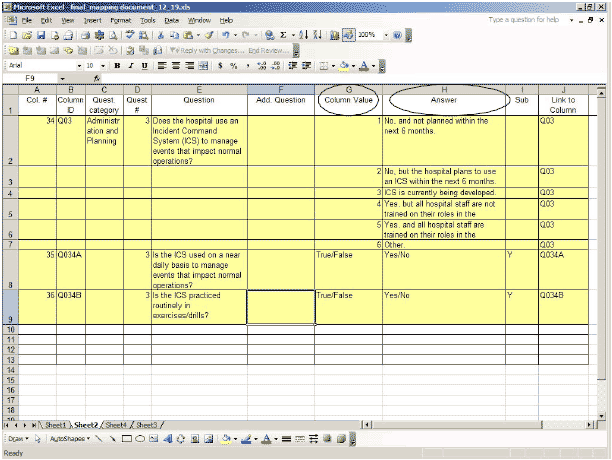
For each parent question and, if present, followup question, the respondent's answers are included under that question's column. The mapping document presents a legend for interpreting the responses. To interpret the data in the analysis file, consult the following columns in the mapping document.

Column Value: This describes the nature of the answer. Four column values are used in this analysis:
Numeric value: For scoring purposes, each potential response to a parent question is assigned a number from 1 through 4, 5, or 6 that corresponds to the numbers of the response options.
True/False: In the followup questions, respondents are asked to select appropriate responses from a table. These are usually "yes" or "no" answers, with "yes" corresponding to "true" and "no" corresponding to "false".
Int: This indicates that responses are in the form of an integer. This is for questions that require a number as a response, typically questions that ask about numbers of beds.
Varchar: This indicates that responses are in the form of variable text characters. This is for questions that allow a free text entry. These are typically located in the demographic sections.
Answer: This is the text version of the response that the user selected.
The following section provides an example of the analysis associated with our sample question, question 3.

For question 3 (Q03), "Does the hospital use an Incident Command System (ICS) to manage events that impact normal operations?" respondent number 4042 answered with response #4, "Yes, but all hospital staff are not trained on their roles in the system." As a result of selecting response #4, the associated table appeared with the six follow up questions. For the first followup question (Q034A), "Is the ICS used on a near daily basis to manage events that impact normal operations?" the respondent had a negative response, reflected as "False" in the analysis file. For the second followup question (Q034B), the respondent also had a negative response. For the third followup question, "Is the ICS updated as needed after exercises/drills?" the respondent had an affirmative response, reflected as "True" in the analysis file.
This section describes a recommended methodology for scoring the hospital/health care systems' data.
For each facility, a total readiness score can be calculated using unweighted scores. Since individual questions have discordant response scales, scores can be recoded as binary in order to align questions, normalize scoring, and stage data for categorical factor analysis. The binary scores were developed by combining affirmative answers and assigning a value of one; assigning a value of zero to negative or neutral answers; and assigning a null value (no impact to the total score) to skipped, missed, or responses of "other." The following question is annotated to convey scoring logic:
Q07. Is the hospital represented in a regional planning group (i.e., local/State public health department) or other groups responsible for regional CBRNE preparedness?
Potential Responses |
Associated Score |
|---|---|
No, and not planned within the next six months. |
0 |
No, but planned within the next six months. |
0 |
Involvement in a regional planning group is being considered. |
0 |
Yes, but there is relatively infrequent interaction between the regional planning group and the hospital. |
1 |
Yes, and there is ongoing interaction between the regional planning group and the hospital. |
1 |
Other. |
0 |
The unweighted scores can be computed for each user by summing the responses for each question answered and dividing by the total number of questions. Missed or skipped questions should be dropped from the total number of questions answered.